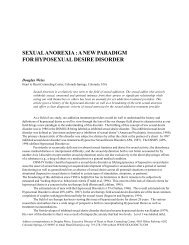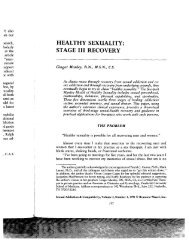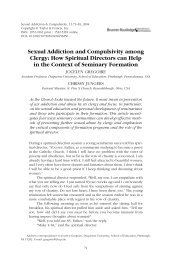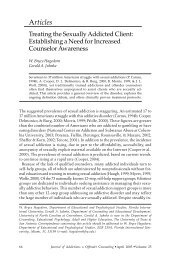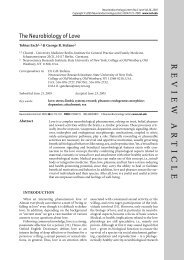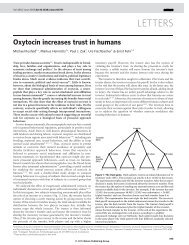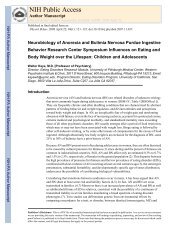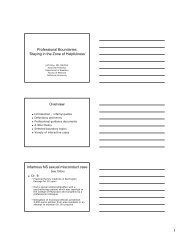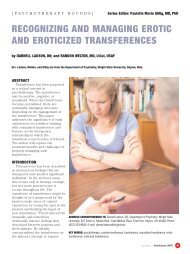Attachment
Attachment
Attachment
Create successful ePaper yourself
Turn your PDF publications into a flip-book with our unique Google optimized e-Paper software.
Understanding and Treating<br />
Problems in Children:<br />
<strong>Attachment</strong><br />
What went wrong, and how can problems be fixed<br />
by Dave Ziegler, Ph.D.<br />
Patterns of<br />
dysfunction in<br />
adulthood can<br />
be causally<br />
linked to the<br />
quality of<br />
very early<br />
attachment.<br />
D<br />
evelopmental psychology, child development and<br />
clinical application with trauma have all played<br />
important roles in a new understanding of<br />
attachment and bonding problems in early<br />
childhood.<br />
The patterns and organization of a human<br />
personality are established early on. The theme of a<br />
person’s story and, to a large extent, the fundamental<br />
success or failure of his or her entire life is established<br />
in early attachment and bonding with his or her<br />
environment.<br />
We are beginning to understand very early<br />
childhood and the precursors to social and<br />
interpersonal success or failure. Patterns of dysfunction<br />
in adulthood can be causally linked to the quality of<br />
very early attachment.<br />
What went wrong<br />
Securely attached infants are more cooperative, less<br />
aggressive and/or avoidant toward their mothers and<br />
other less familiar adults. Later on, they emerge as more<br />
competent and more sympathetic when they interact<br />
with peers. In free-play situations, they have longer<br />
bouts of exploration and display more intense<br />
exploratory interest; in problem-solving situations, they<br />
are more enthusiastic, more persistent and better able<br />
to elicit and accept their mothers’ help. They are more<br />
curious, more self-directed, more ego-resilient, and they<br />
usually tend to achieve better scores on developmental<br />
tests and measures of language development. 1<br />
Some of the most severe attachment disorders are<br />
found with abused and neglected children. The trauma<br />
of abuse produces formidable hurdles for these children<br />
to overcome. <strong>Attachment</strong> is defined by B. James as “a<br />
reciprocal, enduring, emotional and physical affiliation<br />
between a child and a caregiver.” 2 Without attachment,<br />
survival is very much in doubt for one of nature’s<br />
creatures that is most helpless at birth.<br />
<strong>Attachment</strong> Theory<br />
The “traditional attachment theory” was first advanced<br />
by John Bowlby, an English psychiatrist initially trained<br />
as a Freudian psychoanalyst. Bowlby, as well as other<br />
6<br />
Paradigm • Fall 1998
clinicians, had noticed in young children’s response to<br />
loss that there was a somewhat predictable sequence of<br />
behaviors: first, the child protested with anger and<br />
rage; second, the child became depressed and showed<br />
despair; and finally, the child became detached from<br />
people and the environment. 3<br />
Since Bowlby’s early work on attachment starting<br />
in the ’50s, it has been believed that attachment and<br />
bonding may well be essential keys to explaining the<br />
most fundamental psychological and social problems.<br />
Bowlby called the way a child begins to understand his<br />
or her surroundings “inner working models,” and the<br />
model has been found to influence a child’s perceptions<br />
from early childhood on into adulthood. 4<br />
An abused<br />
child may develop a working model of distrusting all<br />
relationships.<br />
Ainsworth’s research on child abuse shows the<br />
effect abuse has on the development of a child far into<br />
the future. 5<br />
Studies have shown that infants whose<br />
relationships with their mothers are more secure are<br />
more competent as toddlers, preschoolers and public<br />
school students. 6<br />
Nurturance the mother experienced<br />
in her own childhood predicted the quality of the<br />
attachment she developed with her own infant. 7<br />
Abusive mothers have been shown to be more<br />
emotionally sensitive to their infants than neglectful<br />
mothers, but less sensitive than non-abusive mothers. 8<br />
There is perhaps a greater risk for children of mothers<br />
who, although they are aware of what the child needs<br />
and wants, do not respond.<br />
More specific to trauma and abuse, research has<br />
also shown that abused and neglected children are<br />
more likely to show avoidance and resistance to their<br />
mothers after even a brief separation. Abused children<br />
have also been found to be more difficult to raise, while<br />
neglected children are more passive, and children in<br />
supportive environments are more cooperative.<br />
In psychology, as in medicine, we are much quicker<br />
to identify a problem than the causes or the solutions to<br />
the problem. It is clear that our society has many<br />
dysfunctional members. There are well over one million<br />
men and women in our jails and prisons. The majority<br />
of men and women in our correctional institutions were<br />
abused children, and many have lived a life of antisocial<br />
behavior. Our drug and alcohol programs are full<br />
with waiting lists; domestic violence, divorce and<br />
broken homes are at the highest level in our history.<br />
Poverty, unemployment and hopelessness exist in<br />
abundance in modern America. Although causative<br />
cultural phenomena can be identified, failure in our<br />
society is experienced one person at a time and one life<br />
at a time. The study of early dispositional patterns<br />
developed in childhood — what can be called secure<br />
and insecure attachment — provides insight into the<br />
ability of some people to overcome life’s obstacles while<br />
others seem unable to do so.<br />
Physical, Emotional and Social Factors<br />
Three components of attachment theory are physical,<br />
emotional and social dimensions. Physical factors<br />
influencing attachment involve aspects of human<br />
physiology including hormones and the central nervous<br />
system. The importance of physical touch and other<br />
senses have already been mentioned. Emotional bonds<br />
are developed (or not developed) rapidly in infants, and<br />
once established, they are long-lasting. The role of<br />
emotions in the attachment process appears to be to<br />
assist in appraisal of the infant’s internal organismic<br />
states and of the external environment.<br />
Social reciprocity is the purpose of attachment.<br />
Physical sensations combine with the infant’s<br />
emotional/intuitive appraisal, producing a behavior that<br />
is social or anti-social. Only if the child can accurately<br />
assess the affective state of another person can they<br />
productively participate in a social interchange.<br />
Instinct<br />
A major influence upon attachment is instinct. The first<br />
instincts of primary importance are the instincts to<br />
survive, to be social and to be adaptable to the<br />
environment. Instincts are not restricted to infants;<br />
they also affect the mother. Deviations in evolutionary<br />
adaptedness, as Bowlby describes instinctive behaviors<br />
that don’t achieve the desired results, can produce<br />
maladaptive behavior patterns. When this occurs, a<br />
negative cycle develops with the child slipping further<br />
and further away from the instinctive goal of<br />
connection.<br />
<strong>Attachment</strong> Theory Behaviorally Defined<br />
<strong>Attachment</strong> theory has been primarily defined in<br />
behavioral terms and can be summarized in eight<br />
important steps:<br />
1. Social responses are first elicited by a wide array<br />
of stimuli. This gradually narrows and after<br />
several months becomes confined to one or<br />
more individuals.<br />
2. A bias develops to respond more to certain<br />
kinds of stimuli than to others.<br />
3. The more experiences of positive social<br />
interaction with a person, the stronger the<br />
attachment becomes.<br />
4. Exposure to human faces produces<br />
discrimination in the attachment figure.<br />
5. The timing of attachment is critical and needs to<br />
develop during the sensitive period within the<br />
first year.<br />
6. The sensitive phase begins sometime after six<br />
weeks (this position has subsequently been<br />
criticized).<br />
7. At the end of the sensitive period, the infant<br />
responds to non-attachment figures with a fear<br />
response, making it difficult to attach after one<br />
year.<br />
8. Once a child becomes strongly attached, they<br />
prefer this person over all others despite<br />
separation.<br />
Whether or not the above processes remain<br />
functional for attachment may depend on the final<br />
phase of four attachment processes in infants: a)<br />
preferences to look at certain patterns and movements;<br />
b) discrimination of one stimuli over another; c)<br />
preference for the familiar; and d) resulting positive<br />
Continued on<br />
page 10<br />
Paradigm • Fall 1998 7
...attachment<br />
problems are<br />
adaptations on<br />
the part of the<br />
child for<br />
survival and<br />
self-protection.<br />
Understanding and Treating<br />
<strong>Attachment</strong><br />
Problems<br />
in Children<br />
Continued from page 7<br />
feedback continues approach behavior, while negative<br />
feedback results in diminished approach response and<br />
then becomes withdrawal behavior.<br />
Efficacious and Problematic Behaviors<br />
There are also disruptive behavior patterns that can<br />
develop which are contrary to the attachment process.<br />
The very early affective or intuitive appraisal of the<br />
environment develops standards or “set points” by<br />
which situations are measured. When set points are<br />
maladapted due to early disruptions, parental bonding<br />
behaviors may be met with anxiety, alarm and anger.<br />
A variety of other behavior patterns can develop<br />
as well. Early negative experiences with hunger,<br />
illness, unhappiness and pain can produce disrupted<br />
bonding. Children have egocentrism, which means that<br />
after 12 months of age, they often construct their own<br />
internal world and can ignore exterior information that<br />
contradicts this internal world. When the focus turns<br />
to abused children, several important outcomes arise:<br />
• Abused children show significantly more<br />
frequent assaultive, harassing and threatening<br />
behaviors.<br />
• They can respond to friendly overtures either<br />
by avoiding interaction or by mixed avoidance<br />
and approach.<br />
• They alienate and avoid adults who might help<br />
them, which can develop a self-perpetuating<br />
cycle.<br />
How Can Problems be Fixed, Recreating<br />
<strong>Attachment</strong><br />
What can we do about attachments that have become<br />
disturbed or that have never developed in any form In<br />
most cases, the presence of a reactive attachment<br />
disorder in a child indicates dysfunction in the parent,<br />
not the child. The clinical focus of all attachment work<br />
must be on the total environment, not solely on the child.<br />
James has identified the roots of attachment in<br />
fundamental interactions such as: crying or responding,<br />
proximity seeking, attention getting and distress or<br />
comfort. The progressive mission of attachment is:<br />
1. Protection of the child.<br />
2. Providing for the many needs of the child.<br />
3. Guiding the child in understanding and<br />
maneuvering in social interaction. 9<br />
A number of factors can disrupt each of these social<br />
transmissions, but few as massively as the trauma<br />
resulting from child abuse. One of the most damaging<br />
dimensions of abuse is how frequently the abuser is a<br />
primary care provider.<br />
Some behaviors that appear to be signs of<br />
attachment in children are actually seriously confused<br />
interactions which reverse the purpose of healthy<br />
attachment. These behaviors have been called trauma<br />
bonds and have as their purpose the protection of the<br />
abuser by the child. These displays of loyalty are bred<br />
upon fear and perhaps even concern for survival on the<br />
part of the child. It is clinically essential to distinguish<br />
between healthy attachment and a trauma bond.<br />
What Must be Fixed<br />
Most attachment disorders are adaptations to initially<br />
unresponsive, painful or otherwise unsuccessful<br />
attempts to attach. A serious clinical challenge arises<br />
when the child’s adaptations become psychologically<br />
ingrained. When this occurs, the child is not aware of<br />
having made the adaptations and doesn’t remember<br />
the reasons for acting the way he or she does. Nearly<br />
all attachment adaptations are pre-cognitive because<br />
they cannot be recalled due to the age of onset, and<br />
they are pre-verbal as well. The deepest levels of<br />
attachment issues are not available to insight or<br />
cognitive interventions.<br />
Factors that Influence Reattachment<br />
The goal in clinical attachment work is to facilitate the<br />
reciprocal, enduring affiliation between parent and child,<br />
if this is possible. This does not mean that attachment<br />
therapy should not be initiated, but it does mean that we<br />
must recognize the stress factors and inhibitors in the<br />
child’s life that potentially work against the clinical goal.<br />
In general, attachment problems are adaptations<br />
on the part of the child for survival and self-protection.<br />
To children who remember, it is like it happened<br />
yesterday. To children too young to remember, their<br />
bodies, through neurological processes that store<br />
trauma memories independently, do the remembering<br />
for them. 10<br />
The clinician or parent cannot hope to<br />
understand the child’s present without understanding<br />
his or her past. Because of past experiences,<br />
expectancies develop that fit the child’s working<br />
models of himself and others. Until clinicians know<br />
this, they cannot know the child.<br />
A Model for Treating <strong>Attachment</strong><br />
Disturbances<br />
B. James has outlined a treatment process for<br />
attachment disorder therapy:<br />
• Individual therapy is inadequate to treat<br />
attachment problems.<br />
• A treatment milieu must be developed.<br />
• Only after a relationship has been developed<br />
can treatment for trauma and loss be effective.<br />
• Children should not be forced to explore their<br />
trauma or loss.<br />
• Young children should not be asked to say<br />
good-bye to a loss without having something to<br />
take its place.<br />
10<br />
Paradigm • Fall 1998
• Provide support, hope and guidance.<br />
• Follow the child’s pace with accepting a loss.<br />
• Provide a nurturing environment where a<br />
relationship of safety, consistency and<br />
emotional closeness is possible.<br />
James’ above points are excellent, and her clinical<br />
handbook on attachment problems is highly<br />
recommended. She identifies five steps in the<br />
treatment of attachment disorders:<br />
1. Teaching.<br />
2. Self-identity work.<br />
3. Affect modulation.<br />
4. Relationship building.<br />
5. Mastering behavior.<br />
While each of the above are clearly important to<br />
treating attachment disorders, it is equally important<br />
in what order the process occurs. The building blocks<br />
can be viewed as a therapeutic staircase that begins<br />
with the bottom step and progressively moves upward.<br />
The important aspect of the staircase analogy is that to<br />
be stable, stairs must be firmly established on the<br />
foundation of the step below. Thus, without safety,<br />
there is no attachment, no relationship and no<br />
successful therapy can occur. The stairs progress from<br />
security through to acceptance, belonging, trust,<br />
relationships and self-awareness.<br />
The building blocks can be used to determine how<br />
far the treatment has progressed and what the next<br />
step should be. It can also be an important diagnostic<br />
tool to consider on what step a child enters treatment<br />
and how far up the stairs they have been able to go. It<br />
is important to mention that a child may be on a<br />
different step with a variety of people. It is also<br />
important to point out the most common<br />
misconception of inexperienced attachment therapists<br />
— believing they have a relationship with a child long<br />
before they have climbed the essential steps.B<br />
References<br />
1. Ainsworth, M.D., S. “Infant-Mother <strong>Attachment</strong>.” American Psychologist, vol. 34,<br />
pgs. 932-937. (1979).<br />
2. James, B. “Handbook for Treatment of <strong>Attachment</strong>-Trauma Problems in Children.”<br />
New York: Lexington Books, Macmillan Inc. (1994).<br />
3. Bowlby, J., “<strong>Attachment</strong>.” New York: Basic Books Inc. (1982).<br />
4. Sroufe, L.A. “The Role of Infant-Caregiver <strong>Attachment</strong> in Development.” From<br />
“Clinical Implication of <strong>Attachment</strong>.” New Jersey: Lawrence Erlbaum Associates.<br />
(1988).<br />
5. Ainsworth, M.D., S., Blehar, M.C., Waters, E., & Wall, S. “Patterns of <strong>Attachment</strong>:<br />
A Psychological Study of the Strange Situation.” New Jersey: Lawrence Erlbaum<br />
Associates. (1978).<br />
6. Belsky, J., Nezworski, T. “Clinical Implication of <strong>Attachment</strong>.” New Jersey:<br />
Lawrence Erlbaum Associates. (1988).<br />
7. Lewis, M., Feiring, C., McGuggog, C., and Jaskir, J. “Predicting Psychopathology<br />
in six-year-olds from early Social Relations.” Child Development, vol. 55, pgs.<br />
1123-1136. (1984).<br />
8. Crittenden, P.M. “Abusing, Neglecting, Problematic, and Adequate Dydadds:<br />
Differentiating by Patterns of Interaction.” Merrill-Palmer Quarterly, vol. 27, pgs.<br />
308-313. (1981).<br />
9. George, C., and Main, M. “Social Interactions of Young Abused Children: Approach,<br />
Avoidance and Aggression.” Child Development, vol. 50, pgs. 306-318. (1979).<br />
10. Van der Kolk, B.A. “The compulsion to repeat the trauma: Re-enactment, revictimization,<br />
and masochism.” Psychiatric Clinics of North America, vol. 12, pgs.<br />
389-406. (1989).<br />
Dave Ziegler holds a doctorate in Counseling Psychology and is a<br />
licensed Marriage and Family Therapist. He founded and directs a program<br />
in the mountains of Oregon where he has lived with troubled children over<br />
the last sixteen years. He gives credit to the children for teaching him about<br />
attachment.<br />
self-awareness<br />
relationships<br />
trust<br />
belonging<br />
acceptance<br />
security<br />
Paradigm • Summer 1998 11 11



